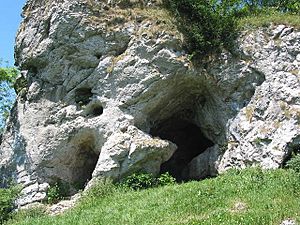Gawain Poet facts for kids
The Gawain Poet is the name we give to the mysterious author of the famous poem Sir Gawain and the Green Knight. This person, who lived in the 14th century, wrote in a language called Middle English. No one knows the poet's real name, so they are named after their most famous work. They are sometimes also called the Pearl Poet.
Besides Sir Gawain, this author probably wrote three other poems: Pearl, Patience, and Cleanness. All four of these amazing poems were found together in a single, handwritten book called the Pearl Manuscript. This manuscript is now kept safely in the British Library.
The Gawain Poet's work is considered some of the best poetry ever written in Middle English. Even though we don't know who they were, their stories have been loved for centuries.
Contents
Who Was the Gawain Poet?
We don't know the poet's name, but the poems themselves give us clues. The author was writing around the same time as other famous poets like Geoffrey Chaucer and William Langland. This was during the reign of King Richard II of England.
Clues from Language
The poems are written in a specific dialect of Middle English. This dialect comes from the northwest midlands of England. This area includes parts of modern-day Cheshire, Staffordshire, and Shropshire. This suggests the poet was probably from this region.
The poet was clearly well-educated. Their poems show a deep understanding of many subjects.
- Hunting and Courts: The author knew the special calls and signals used in hunting. They also seemed to know how royal courts worked.
- Religion: The poems are full of stories and ideas from the Vulgate Bible. The poet knew these stories well and used them to teach lessons about faith and morality.
- Nature: The poems include beautiful, vivid descriptions of the English countryside.
Even with all this knowledge, the poet doesn't seem like a university professor or a monk. They were more interested in old legends, like the stories of King Arthur, than in new ideas. Because of this, many experts believe the poet was a member of a wealthy, land-owning family.
In 1925, the famous author J. R. R. Tolkien (who wrote The Lord of the Rings) and his colleague E. V. Gordon studied the poems. They described the poet as:
He was a man of serious and devout mind, though not without humour; he had an interest in theology, and some knowledge of it... he had Latin and French and was well enough read in French books... but his home was in the West Midlands of England.
When Were the Poems Written?
It's hard to know the exact date the poems were written. They could have been created anytime between the 1360s and 1400, which is when the manuscript was made. Most experts agree the poet was probably writing between the mid-1370s and mid-1380s.
The poems are part of a movement called the "Alliterative Revival". This was a time when many poets in England started writing poems that used alliteration (repeating the same sound at the beginning of words), a style popular in older English poetry.
Theories About the Poet's Identity
For centuries, people have tried to guess the Gawain Poet's real name. While we have no definite proof, there are several interesting theories.
Was the Poet a Massey?
One of the most popular theories is that the poet was a member of the Massey family. The Masseys were an important family in Cheshire, the same area the poet's dialect is from.
A different poem, Saint Erkenwald, is sometimes thought to be by the Gawain Poet. The names "Thomas Massey" and "Elizabeth Booth" (from another important Cheshire family) are written in the manuscript for that poem.
Later, a scholar suggested the author was John Massey of Cotton, Cheshire. This idea is supported by a poem from another writer, Thomas Hoccleve. Hoccleve mentioned a "maister Massy" who was a tough critic of poetry. However, not all experts agree with this theory.
Was the Poet Sir John Stanley?
Another candidate is Sir John Stanley (about 1350–1414). He was a Knight of the Garter, a high honor given by the king.
This theory is interesting because the motto of the Order of the Garter, Honi soit qui mal y pense ("Shame on him who thinks evil of it"), appears at the very end of Sir Gawain and the Green Knight. Sir John Stanley was also from the right part of England and was familiar with hunting and armor, just like the poet.
Other Ideas
Over the years, other names have been suggested, but none have been proven.
- "Huchoun": In the early 20th century, some thought the poet was a Scottish man named Huchoun ("little Hugh"). This was because the name "Hugo de" was written in the manuscript. This theory is not popular today because the poems linked to Huchoun were written in different dialects.
- John Prat or John Donne: These men were clerks who worked for the Earl of Pembroke. Some believe the poem Pearl was written about the Earl's daughter, making them possible authors.
For now, the author's true identity remains a secret. Calling them the "Gawain Poet" reminds us that it is their incredible poems that truly matter.
See also
 In Spanish: Poeta Pearl para niños
In Spanish: Poeta Pearl para niños



